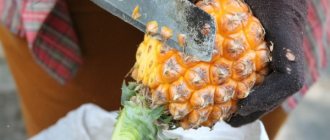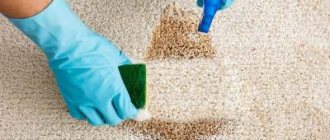Pineapple is a tasty and healthy product. It is often used to decorate a festive table and various dishes. If it comes to our house in canned form or candied fruit, then there are no questions about how to peel and cut this fruit. And if we come across fresh fruit, it would seem, take it and eat it.
It's not that simple, dear friends. To appreciate all the delights of this tropical fruit, you need to understand the peculiarities of selection, cutting and preparation for serving.
Choose a ripe and juicy pineapple
Before you eat a delicious fruit, you need to choose it correctly. There are several simple rules for choosing pineapples, following which you will certainly be satisfied with your purchase. Let's take a closer look at what you should pay attention to first:
- the leaves at the top should be a rich green color, without yellowness or spots. The leaves of a ripe fruit are easily torn off by hand, without unnecessary effort;
- do not buy these tropical fruits without the top - most likely, this indicates the beginning of rotting of the plant;
- an overly tight tip indicates unripe fruit;
- the peel of a ripe fruit has a yellow-green color, a uniform brown tint of the scales indicates the overripeness of the tasty fruit;
- To the touch, ripe pineapples have an elastic shell that restores its natural shape when lightly pressed with a finger. Increased hardness or softness of the shell indicates an unripe or overripe state;
- any visible deformations that occur during transportation or storage may make this product unsuitable for consumption; if there is visible damage, you should not risk your health; the product may be damaged;
- pay attention to the aroma. It should be soft, appetizing, reminiscent of a melon. The smell should under no circumstances be pungent or offensive.
Useful properties of pineapple
Pineapple is not only a very tasty delicacy, but also a storehouse of useful vitamins and microelements. It contains sucrose, iron, copper, calcium, zinc and iodine, vitamins A, B, C, ascorbic and citric acid. It is recommended to be used for problems with the gastrointestinal tract, thrombosis, edema, obesity, etc.
86% of pineapple pulp is water. It is a low-calorie food (100 g of product contains 48 kcal). The potassium salt contained in the fruit improves the body's metabolism and removes excess fluid. One hundred grams of this delicious dish contains the daily requirement of vitamin C and 75% of the norm of manganese to strengthen bones and connective tissues.
When moving through air and water, a glass of pineapple juice will help prevent nausea. Pineapples are often used for cosmetic purposes.
Storage rules
In order for pineapple not to lose its taste, you need to be able to not only choose it correctly, but also choose the right storage conditions:
- The fruit should be stored at room temperature, approximately 15-18 degrees.
- You should not keep it in the refrigerator, as it can lose its aroma in it.
- It is not advisable to move it to a room where there will be a sharp change in temperature.
- The best storage container is a container with special holes.
- Pineapple can maintain its freshness for 12-16 days.
- It can absorb odors, so it should be kept away from foods with strong odors.
- Fruits should not be left in a sunny place.
- Stores sell a special knife that can be used to easily pull out the middle.
- It is not recommended to eat this fruit after eating meat.
Popular articles Wooden shelf
What tools are needed to peel a pineapple?
Depending on the chosen cleaning method, we will need the following kitchen equipment:
- 2 large well sharpened knives. The pineapple shell is quite strong and the size of the fruit is often not small, so the knife should be as convenient as possible.
- a small potato knife is perfect for removing remaining eyes after peeling;
- cutting board (dimensions and material of the product are at your discretion, the main criterion is convenience and practicality);
- a potato peeler is a good alternative to a potato knife;
- container for the finished product - a large deep plate is perfect, in which it will be convenient to put the chopped pieces.
- A slicer is an indispensable thing for frequent consumption of pineapple, which will reduce the time of cutting the exotic fruit to a minimum.
The border between the peel and the pulp contains the substance bromelain, which is very useful. Its use promotes the breakdown of fats. But it has one significant drawback: due to its increased acidity, when it comes into contact with the mucous membrane, it causes a burning sensation and irritation of the mucous membrane. In this regard, the cleaning and cutting process is performed with two different knives.
Video: how to peel a pineapple with a knife
Step-by-step instructions and methods on how to peel a pineapple
The difficulty of peeling a pineapple is due to the external structure of the shell, which has a grooved shape. If you cut it incorrectly, you can ruin the taste of the fruit. We will analyze in detail the cleaning methods on which you will spend a minimum of time and pamper your loved ones with a juicy dessert.
Vertical trimming
This cleaning method is suitable if you need to get solid rings. Recommended for fresh consumption and preparation of various dishes. The pruning process using this method occurs in the following sequence:
- remove the top and bottom of the fruit. The layer to be removed should be approximately 1-2 cm. Since the pulp in these areas is hard, you should not be particularly sorry for it;
- place the trimmed fruit on a cutting board in a vertical position (according to the name of the method);
- Using a sharp long knife, trim the peel around the entire perimeter. Choose the thickness of the layer yourself, it depends only on the time required: if you don’t have time, remove the thick layer, the eyes will remain on the peel, and you will lose some of the pulp. For thinner layers of peeling, the surface will have to be refined with a potato peeler or a thin sharp knife;
- remove the core using a thin, sharp knife.
Eastern method of preparing pineapple
In eastern countries, pineapple is often served for dessert. This is a quick cleaning method, since it does not remove the peel; the cutting occurs in slices resembling a melon in shape. The stages of the cleaning process are as follows:
- cut the delicacy into four equal parts, without damaging the top with leaves;
- On each part, separate the peel from the pulp by cutting it with a sharp knife;
- Carefully remove the core from each cut piece;
- Use a sharp knife to chop the pineapple pulp into large, equal pieces;
- Place the chopped pieces on the previously separated parts of the peel.
In this rather practical way, you can please your guests with a beautifully served dish, without spending a lot of time and effort.
Partial peeling of the fruit for your own consumption
This is a good cleaning method when eating the fruit at home. The pineapple is expected to be eaten piecemeal and care must be taken to ensure it does not spoil prematurely. Taking into account the fact that the shelf life of this product without peel is significantly reduced. The cleaning algorithm is as follows:
- cut off the top;
- cut off several thin rings;
- Using a knife, cut off the peel from the resulting rings;
- cut the resulting pulp into slices;
- remove the core from the resulting slices;
- Cover the rest of the product with cling film and put it in the refrigerator. The shelf life in this form ranges from 2 to 7 days, depending on the maturity of the fruit.
Step-by-step descriptions with photos
We've rounded up some simple but globally popular options for peeling and slicing pineapple. Try to master them, and soon this healthy and tasty fruit will take its rightful place on your table.
This is how to properly peel a pineapple
In fact, it is quite possible to cope with peeling a pineapple if you follow the generally accepted scheme for this, which must have been proven by centuries of experience of various tropical peoples, and do not try to twirl it in your hands and cut off the tough skin with a potato peeler.
Progress:
- We take a board, a large carving knife (aka “chef”) and a small knife, usually used for cutting eyes out of potatoes. Place the pineapple on a board and remove the bottom and leaves along with the top cap of the fruit.
- We put the fruit on the cut and cut off the tough skin, trying to “catch” as little pulp as possible.
- The result was a yellow “barrel” with dark spots. Using a small and sharp knife, we methodically remove these dark seals.
- We cut the “barrel” lengthwise into four parts, after which we remove the dense and fibrous core.
- We cut the fruit quarters into cubes or slices, depending on their further use.
You can also clean it beautifully: spiral patterns
- The beginning is the same as for the “barrel”: we place it on the board, cut off the bottom and the cap with leaves.
- We cut the pineapple and peel it.
- We lay it on its side and cut out the “eyes” diagonally to end up with a solid line-spiral.
- We divide the “little jar” into four parts.
- We remove the lighter and harder core.
- Divide the quarters in half.
- We cut the resulting blanks at our discretion, for example, into small pieces.
Video: master class on cutting pineapple
Women's method: just cut into rings or circles
An extremely simple method that does not require skill or much strength. It will be especially good when you need to quickly chop pineapple for a salad or stir-fry.
Procedure:
- Cut off the bottom of the pineapple.
- We cut the circles without first cleaning the fruit.
- Remove the skin from each circle in a thick layer, making sure that the dark spots remain in the peelings. If you want to preserve the pulp as much as possible, peel the peel in a thin layer and cut out the seals with a knife with a sharp end or a special knife for peeling potatoes.
- Cut out the tree-like core into a circle. Or we leave it and inform guests that they only need to hold a piece for it.
- If the fruit is served to children, then it is better not to cut it too finely and it is also better not to touch the core. Just cut the mugs into two parts: children will eat the slices with their hands, holding onto the hard and non-slip center.
Video: experiment on high-speed cutting of pineapple
Boats for the festive table
One thing can be said about this method of peeling and cutting pineapple: “First of all, it’s beautiful...”.
Pineapple “boats” are one of the most beautiful ways to cut and serve
- Cut the unpeeled pineapple lengthwise into four pieces.
- Remove the hard core from each part.
- Separate the pulp from the skin in one piece, avoiding dark seals.
- Cut into slices, 1 cm thick. Slightly move the pieces in a checkerboard pattern. The result is elegant boats that will rightfully decorate and refresh the festive table.
Squeezing out the pulp with a special knife
For special gourmets of this delicacy, a special slicer is perfect. A very necessary thing in the household. With its help, the pineapple is cut into perfect slices. The shape of the slicer resembles a plastic or metal corkscrew with sharp plates, specially designed for this type of fruit.
Slicers are mechanical and electrical, for household and industrial purposes. The process of cutting with a mechanical household device is quite simple and will not take more than two minutes:
- cut off the top with leaves from the pineapple, place the tropical fruit in a vertical position;
- insert the slicer into the core of the pineapple and screw it into the pulp according to the principle of a regular corkscrew;
- having reached the base, remove the slicer from the fruit.
You will end up with an empty bowl-shaped peel and perfectly cut flesh in the shape of circles.
Remove the core from the peel and you have an original container for fruit salad in pineapple!
Decorative basket for a festive feast
Another great option to surprise your guests is the way of serving an exotic fruit in a basket. Thanks to a good imagination, you can make a very original thing. To make a basket you need:
- Cut the pineapple into two equal parts.
- Cut out all the pulp, paying attention to the thickness of the resulting walls; they should not be too thin.
- Carefully cut cubes and triangles from the resulting pulp.
- Place the juicy pieces into pre-prepared baskets. If desired, you can add grapes or mint leaves.
The resulting baskets can be used for fruit salads made from other berry ingredients. Baskets with cut-out handles will look impressive.
Slicing device
To quickly peel the fruit from its hard peel, it is recommended to use a special slicing device called a slicer. It is a corkscrew and has a similar operating principle. The device must be screwed into the center of the fruit and the pulp must be separated from the middle and the skin. The edible part is cut into a spiral. Before cutting the product, you will need to slowly screw the slicer clockwise into the pineapple. The core should remain in the handle of the device. As a result, the skin will remain intact and can be used to serve pineapple.
The edible part of the fruit will be held on the handle of the corkscrew and at the same time will be cut into equal thin circles. Peeling a pineapple using a slicer will take no more than 1 minute. As a result, it is possible to quickly remove the skin from the product and cut it beautifully.
How to properly core a pineapple?
It is not recommended to eat the pineapple core; it is tough and fibrous. Depending on the form of further use of the pineapple, there are different ways to extract the central part. Let's look at them in more detail:
- If it is necessary not to damage the integrity of the fruit, you can use a long, sharp knife with a narrow blade.
- You can get rid of the core by cutting the fruit into rings and using a small knife to remove everything unnecessary.
- The easiest way is to cut the pineapple into 4 parts and cut out the core with a knife.
Some doctors still recommend eating the central part of the pineapple to prevent intestinal constipation, since dietary fiber is not absorbed by the body and is excreted.
Cutting the fruit beautifully: creating a fruit plate
After we have figured out the options for cleaning pineapple, the question arises: how to beautifully serve the sliced product and surprise your guests with the original design of this exotic dish? There are many ways to present juicy ripe fruit on a fruit plate with a bright and beautiful design. We will analyze one of them in detail:
- Wash the pineapple well under running water and dry it thoroughly with a towel;
- cut off the top with the leaves and put it aside for a while, we will still need it for further decoration;
- cut the ripe fruit into 5 equal parts;
- Carefully cut off all the peel from each cut part, try not to spoil it;
- place the pulp on a cutting board and use a knife to separate each piece with one longitudinal and four transverse cuts;
- take a large plate, arrange the peels in a circle in the form of boats and carefully place the resulting pieces back into their peels;
- place the green top in the central part of the plate;
- wash some cherries and cherries, prick them onto skewers, insert the skewers into each slice of juicy pineapple;
- Place pieces of other fruits and berries between the boats. The following will do the job perfectly: apples, pears, plums, bananas, kiwis and other delicious treats.
Show your imagination and create your own unique composition of a fruit plate. Feel free to experiment; on the Internet there are many options for various dishes that will become a real decoration for your table.
Why remove the peel?
Whether or not to peel a pineapple depends on the type of cooking and serving of the fruit. If the product needs to be cut into pieces or added to a dish, it is recommended to remove the skin. The juiciest edible part is located under the skin. Therefore, the skin must be removed very thinly, using a knife with a sharp blade. If the product is planned to be served as sliced fruit, the tops with skins can be left and used as decoration. To do this, you will need to rinse the pineapple well under running water and dry it with paper towels.
If the fruit is not peeled, it will remain fresh for a long period of time. The skin protects the product from drying out and chapping.











